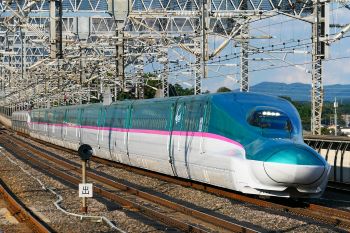Passenger train services • Main line services / Ticketing • High speed Rail • Japan • JR Hokaido
➤ See also: Shinkansen overview – Shinkansen infrastructure and stations – JR East – JR Central – JR West – JR Kyushu
➤ See also: High speed train in France – High speed train in Germany – High speed train in Italy – Economics
Note: For educational purpose only. This page is meant purely as a documentation tool and has no legal effect. It is not a substitute for the official page of the operating company, manufacturer or official institutions. It cannot be used for staff training, which is the responsibility of approved institutions and companies.
👉 (Version française disponible)
In brief
In April 1987, the Japanese National Railways (JNR) were divided into seven companies: one for freight and six for passenger transport, known as JR. We will briefly present the high-speed rolling stock of each of these companies : JR Hokkaido, JR East, JR Central, JR West and JR Kyushu.
The JR Hokkaido Shinkansen is a high-speed rail line operated by Hokkaido Railway Company (JR Hokkaido) that connects Hokkaido with Honshu, Japan’s main island. Opened in March 2016, it currently runs from Shin-Aomori Station in Aomori Prefecture to Shin-Hakodate-Hokuto Station in southern Hokkaido.
Infrastructure managers: JR Hokkaido
Operators: JR Hokkaido
First services: March 2016
Lenght of Shinkansen network: 149 km
Speed: 250 to 260km/h
The Hokkaido Shinkansen is part of Japan’s extensive high-speed rail network, offering speeds of up to 260 km/h (161 mph). It primarily utilizes the H5 Series Shinkansen, designed for comfort and resilience against Hokkaido’s cold climate. Spacious seating and advanced safety features make it a premium travel option.
Future plans include extending the line to Sapporo, Hokkaido’s largest city, by 2031, reducing travel time between Tokyo and Sapporo to approximately four hours. This will boost tourism and economic ties in northern Japan.
The definition of a high-speed train varies by region, but generally, it refers to trains that operate at speeds of at least 250 km/h (155 mph) on newly built lines and 200 km/h (124 mph) on upgraded lines. In Europe, for example, the UIC (International Union of Railways) considers a commercial speed of 250 km/h as the principal criterion for high-speed rail. In the United States, the definition can include trains operating at speeds ranging from 180 km/h (110 mph) to 240 km/h (150 mph).
➤ See the UIC definition
National rolling stock (past and present)

Hitachi Rail, Kawasaki Heavy Industries
2011/2016 – …
[TOP]
Infrastructure • High speed Rail • Japan • Lexical
